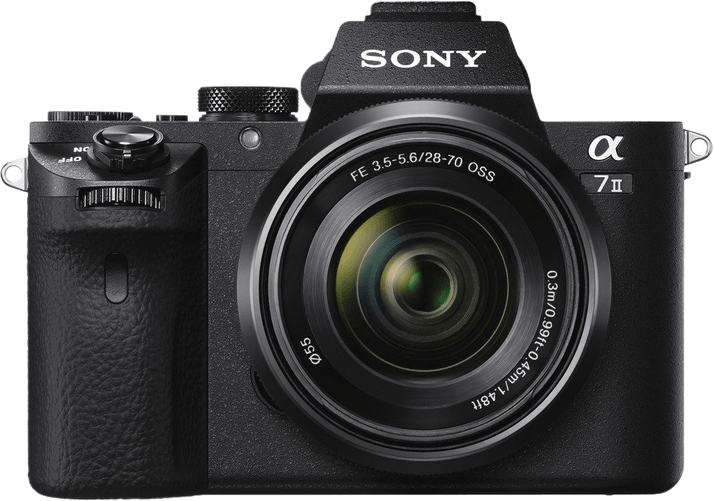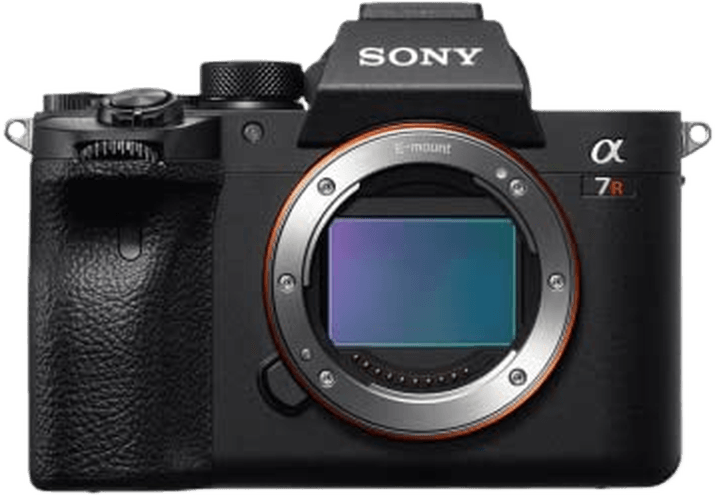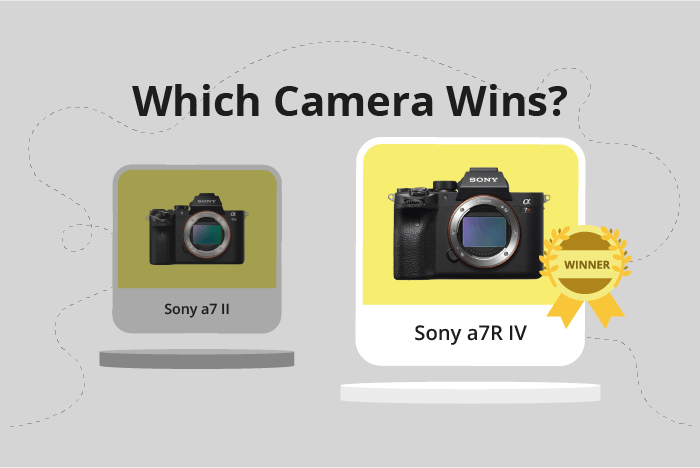Sony a7 II vs a7R IV Comparison
Sony a7 II

Sony a7R IV

The Sony a7R IV outperforms the Sony a7 II with a score of 84/100 compared to 68/100. Both cameras share similarities, such as being mirrorless and having similar dimensions. The a7R IV, however, is slightly larger and heavier at 129 x 96 x 78mm and 665g, while the a7 II measures 127 x 96 x 60mm and weighs 599g.
The a7R IV’s higher score highlights its superior features, such as a more recent release date (2019) and a higher launch price ($3500), indicating advanced technology and performance. On the other hand, the a7 II, released in 2014, offers a more affordable option at $1600, making it a better choice for those on a budget.
In comparing these two cameras, the Sony a7R IV stands out as a more advanced and feature-rich option, while the Sony a7 II offers affordability for those with budget constraints.
Sony a7 II vs a7R IV Overview and Optics
The Sony a7R IV outperforms the Sony a7 II in optics, with a score of 85/100 compared to 78/100. Both cameras share several specifications, such as a CMOS sensor, Bionz X processor, full-frame sensor size, Sony lens mounts, and image stabilization. However, the a7R IV has superior features that contribute to its higher score.
The a7R IV boasts a remarkable 61.2 megapixels, significantly more than the a7 II’s 24.2 megapixels. This difference allows for greater image detail and better performance in large print photography. Additionally, the a7R IV has a faster shooting speed of 10 frames per second, double the a7 II’s 5 frames per second. This faster speed enables the a7R IV to capture fast-moving subjects with ease. Furthermore, the a7R IV’s sensor has a DXOMARK score of 99, outshining the a7 II’s score of 90, indicating better overall image quality and low-light performance.
On the other hand, the a7 II has some advantages, such as being more affordable and lighter in weight, making it a suitable choice for those on a budget or who prioritize portability. However, these advantages do not outweigh the optical superiority of the a7R IV.
Taking all factors into account, the Sony a7R IV proves to be the better camera in terms of optics, offering higher resolution, faster shooting speed, and better sensor performance. While the Sony a7 II remains a viable option for those with budget constraints or seeking a more compact camera, those seeking top-notch optical performance should opt for the Sony a7R IV.
Sony a7 II vs a7R IV Video Performance
The Sony a7R IV outperforms the Sony a7 II in video capabilities, with a score of 70/100 compared to the a7 II’s 56/100. Both cameras share some common video specifications, but the a7R IV has notable advantages that contribute to its higher score.
The a7R IV and a7 II both offer Full HD video recording, with maximum dimensions of 1920 x 1080. However, the a7R IV takes it a step further with 4K video resolution and dimensions of 3840 x 2160, providing more detail and higher quality footage. The a7R IV’s maximum video frame rate is 30fps, whereas the a7 II can reach up to 60fps. Despite having a lower frame rate, the a7R IV’s 4K resolution compensates for this difference.
Another advantage of the a7R IV is its built-in time-lapse functionality, which the a7 II lacks. This feature allows users to create stunning time-lapse videos without the need for additional equipment or software.
The a7 II’s higher frame rate of 60fps is its only advantage over the a7R IV. This higher frame rate can be useful for capturing fast-moving subjects or creating slow-motion footage. However, the overall video quality and capabilities of the a7R IV are superior.
The Sony a7R IV’s 4K video resolution, larger video dimensions, and built-in time-lapse functionality make it the better choice for videographers and content creators. While the Sony a7 II has a higher frame rate, it falls short in other aspects of video performance. Therefore, the a7R IV is the clear winner in video capabilities.
Sony a7 II vs a7R IV Features and Benefits
The Sony a7R IV outperforms the Sony a7 II in features with a score of 83/100 compared to the latter’s 57/100. Both cameras share several specifications, including a 3-inch screen size, flip screen, lack of GPS, and Wi-Fi connectivity. However, the a7R IV surpasses the a7 II in specific aspects, making it the superior camera in terms of features.
The a7R IV boasts a higher screen resolution of 1,440,000 dots, as opposed to the a7 II’s 1,230,000 dots, resulting in a sharper and clearer display. Furthermore, the a7R IV has a touchscreen, making navigation and control more intuitive and user-friendly. Additionally, the a7R IV includes Bluetooth connectivity, providing more options for remote control and file transfer.
While the a7 II trails behind in these features, it still offers a flip screen and Wi-Fi connectivity, which are useful for various shooting situations and transferring files. However, its lack of a touchscreen and Bluetooth connectivity hinder its overall capabilities compared to the a7R IV.
Considering the differences in features, the Sony a7R IV is the clear winner, with a higher screen resolution, touchscreen, and Bluetooth connectivity. These enhancements contribute to a more seamless and efficient shooting experience. On the other hand, the Sony a7 II is a decent option for those seeking a camera with a flip screen and Wi-Fi connectivity, but its limitations in other features make it less competitive in comparison to the a7R IV.
Sony a7 II vs a7R IV Storage and Battery
The Sony a7R IV outperforms the Sony a7 II in storage and battery, earning a score of 79/100 compared to the a7 II’s 21/100. Both cameras accept SD, SDHC, and SDXC memory cards, as well as Memory Stick Duo, Pro Duo, and Pro-HG Duo. However, the a7R IV surpasses the a7 II with two memory card slots and compatibility with UHS-II cards, offering users greater storage flexibility.
The a7R IV’s battery life of 670 shots significantly exceeds the a7 II’s 350 shots, thanks to its NP-FZ100 battery. Additionally, the a7R IV supports USB charging, providing further convenience to users. The a7 II, with its NP-FW50 battery, lacks this feature.
Considering these aspects, the Sony a7R IV is the superior camera in terms of storage and battery capabilities, while the Sony a7 II falls short in comparison. The a7R IV’s enhanced storage options and extended battery life make it a more practical choice for photographers.
Sony a7 II vs a7R IV – Our Verdict
Are you still undecided about which camera is right for you? Have a look at these popular comparisons that feature the Sony a7 II or the Sony a7R IV:

